| Notes: The Harborne Railway, running for just over two miles was, authorised by an Act of Parliament dated 28 June 1866. It had been part of a larger scheme put before Parliament in the 1866 session with a projected junction with the London & North Western Railway (LNWR) at Monument Lane and a further junction with the Great Western Railway (GWR) at Soho. Simmons (1986) suggests that the original purpose in building the line might have been to retain for Harborne the industry that was migrating to Smethwick in the northern part of the parish where there were a canal, two railways and four stations. The line was to be a through route connecting with the Halesowen and Bromsgrove Branch Railway (HBBR) at Lapal near Halesowen. The only part of the line which was not opposed by the GWR and Birmingham Corporation (City Council) was the section from the LNWR to Harborne. When the Harborne Railway Company (HRC) withdrew the GWR junction at Soho and the extension from Harborne to Halesowen the Bill was passed. The HRC was allowed five years to construct the branch, although construction was painfully slow, and in 1870 the company was granted a three-year extension. A working agreement between the HRC and the LNWR was drawn up in 1873, with the LNWR operating, staffing, maintaining and providing rolling stock, in return for 50 per cent of the gross receipts.
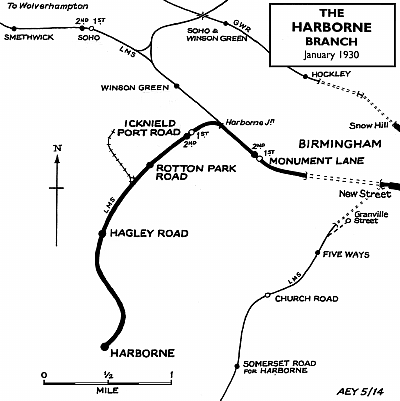 The line opened on 10 August 1874 and it enabled Harborne to develop into a comfortable residential suburb.
The terminus station at Harborne opened on the same day as the line and was by far the grandest on the line. It consisted of a single platform with run-round loop and a 42ft turntable located at the southern end of the platform with sidings and a goods shed provided. With the building of the Chad Valley Works in 1897 goods traffic to and from Harborne increased considerably. An undistinguished single-storey brick building with a ridged roof stood on Station Road containing the booking office and waiting rooms. A glazed verandah of ridged profile extended over the platform, and a small flat awning with a serrated valance protected the station entrance. The line opened on 10 August 1874 and it enabled Harborne to develop into a comfortable residential suburb.
The terminus station at Harborne opened on the same day as the line and was by far the grandest on the line. It consisted of a single platform with run-round loop and a 42ft turntable located at the southern end of the platform with sidings and a goods shed provided. With the building of the Chad Valley Works in 1897 goods traffic to and from Harborne increased considerably. An undistinguished single-storey brick building with a ridged roof stood on Station Road containing the booking office and waiting rooms. A glazed verandah of ridged profile extended over the platform, and a small flat awning with a serrated valance protected the station entrance.
The initial service was six trains in each direction on Monday-to-Saturday with three in each direction on Sunday; two of the weekday trains operated as Parliamentary services, although all other services conveyed first, second and third class passengers. The Sunday service was short-lived owing to the residents of Hagley Road complaining about the ‘disturbance of their Sabbath‘.
During the first few years of operation the line was a financial success but this was not to continue. In 1879 the company went into Chancery owing to being petitioned by the rent charge holders with a Receiver being appointed by the Court of Chancery on 26 July of that year. It was not until 31 December 1900 that the company was released from Chancery having paid off all its debts. In the meantime the LNWR had made several abortive attempts to purchase the line outright but was continually rebuffed by the owners. Dividends paid by the company were never high, although during the period 1919 to 1922 a dividend of 3 per cent was paid.
During 1893 the platform at Harborne was lengthened to accommodate longer trains, and in 1901 a 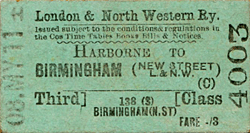 second platform was constructed alongside the run-round loop; this was in conjunction with other improvements made along the line to provide extra capacity for the passenger service. With the building of the Harborne Estates in 1908 a lengthy footbridge was constructed which gave residents direct access to the station. The second platform was never used nor ever physically connected to the station and was removed in 1911 being replaced with additional siding space for the storage of carriages. second platform was constructed alongside the run-round loop; this was in conjunction with other improvements made along the line to provide extra capacity for the passenger service. With the building of the Harborne Estates in 1908 a lengthy footbridge was constructed which gave residents direct access to the station. The second platform was never used nor ever physically connected to the station and was removed in 1911 being replaced with additional siding space for the storage of carriages.
From its initial six trains per day the passenger service had improved by 1895 when Bradshaw shows 19 down workings from Birmingham to Harborne on Monday-to-Friday with 18 on Saturday. There were 20 up services on Monday-to-Friday with 19 on Saturday. To placate the Hagley Road residents there was still no Sunday service. The line enjoyed its most intensive passenger service in the years prior to World War I, the 1910 timetable showing 30 up and down workings on weekdays every hour from 6.45am until 10.45pm. This made the line the busiest suburban route in Birmingham and was a very early example of regular interval working. Many of the residents along the branch used it not only to travel to work in the morning and back in the evening, but the short journey and frequent service enabled them to return home for lunch.
| Deprtures December 1895 |
To |
Arrivals December 1895 |
From |
| 6.45am |
Birmingham New Street |
7.30am |
Birmingham New Street |
| 7.50am |
Birmingham New Street |
8.10am |
Birmingham New Street |
| 8.25am |
Birmingham New Street |
9.35am |
Birmingham New Street |
| 8.55am |
Birmingham New Street |
10.30am |
Birmingham New Street |
| 9.10am |
Birmingham New Street |
12.30pm |
Birmingham New Street |
| 9.43am |
Birmingham New Street |
1.10pm |
Birmingham New Street |
| 10.40am |
Birmingham New Street |
1.30pm SX |
Birmingham New Street |
| 12.40pm |
Birmingham New Street |
1.35pm SO |
Birmingham New Street |
| 1.45pm |
Birmingham New Street |
2.30pm |
Birmingham New Street |
| 2.10pm SX |
Birmingham New Street |
3.30pm |
Birmingham New Street |
| 2.50pm |
Birmingham New Street |
4.35pm |
Birmingham New Street |
| 3.45pm |
Birmingham New Street |
5.30pm |
Birmingham New Street |
| 4.45pm |
Birmingham New Street |
6.15pm SX |
Birmingham New Street |
| 5.40pm |
Birmingham New Street |
6.40pm |
Birmingham New Street |
| 6.50pm |
Birmingham New Street |
7.30pm |
Birmingham New Street |
| 7.50pm |
Birmingham New Street |
8.30pm |
Birmingham New Street |
| 8.45pm |
Birmingham New Street |
9.30pm |
Birmingham New Street |
| 9.50pm |
Birmingham New Street |
10.15pm |
Birmingham New Street |
| 10.22pm |
Birmingham New Street |
11.00pm |
Birmingham New Street |
| 11.07pm |
Birmingham New Street |
11.45pm |
Birmingham New Street |
The frequent service continued until the end of World War I when three factors started to affect passenger numbers, although the first two had been in operation for several years. The first was the LNWR’s practice of holding the branch train at the junction with the main line even if an express train was late. This delay was followed by the mandatory ticket inspection stop at Monument Lane station, as New Street was an ‘open’ station. As a result the 25 minute journey from Harborne to Birmingham would often take more than 30 minutes. The final factor came in the shape of the newly created Omnibus Company which used surplus vehicles sold off by the Government after the war.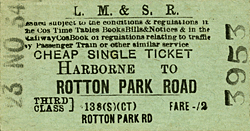
The time taken by the trains to reach New Street prompted the travelling public to refer ironically to their service as ‘The Harborne Express’. The HRC fought back against the road competition with a price war, and this continued when, at the Grouping of 1923, the line became property of the London Midland & Scottish Railway (LMS). The LMS reduced prices so much that by the early 1930s a day return from Harborne to Birmingham cost as little as 3d (1.25p). This did not attract as many passengers as the LMS had wished, and in October 1934 notice was given by that passenger services were to be withdrawn. The final train was the crowded 11.08pm Birmingham New Street to Harborne on Saturday 24 November, with official closure two days later on 26 November 1934. Withdrawal of passenger services was uncommon in the pre-World War II era, and it caused considerable comment at the time; however this had no effect.
The booking office at Harborne was closed but the station would still see considerable freight activity. The nearby Chad Valley Toy Company used the offices and single platform for the storage of wood for its products. The branch was still remunerative in the 1950s with coal and sand traffic to Harborne, the sand being stored in a wharf where the turntable once stood. The branch enjoyed three freight workings on weekdays with a morning, afternoon and evening trip.
On 3 June 1950 the line saw its first passenger service for over 16 years with a Stephenson Locomotive Society (SLS) special being run from New Street at 3.10pm. The working comprised an LNWR 2-4-2 tank with a two-coach push-pull set. Considerable local interest was aroused by 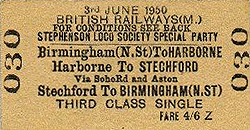 this working, with the train being seen off from New Street by the stationmaster complete with top hat and tails. Many local residents lined the route to cheer its first passenger train for 16 years. The train was packed to capacity with enthusiasts and former regular users of the line; one such user was the guard of the final working in 1934, a Mr Perkins. Since that 1950 working the branch saw several visits from railtours with the last one coming to commemorate the final closure of the line on 3 November 1963. Hauled by LMS Ivatt 2-6-0MT No.46429 it was another SLS excursion, well loaded with enthusiasts who alighted to swarm all over the track at the terminus. The line would be lifted shortly after. this working, with the train being seen off from New Street by the stationmaster complete with top hat and tails. Many local residents lined the route to cheer its first passenger train for 16 years. The train was packed to capacity with enthusiasts and former regular users of the line; one such user was the guard of the final working in 1934, a Mr Perkins. Since that 1950 working the branch saw several visits from railtours with the last one coming to commemorate the final closure of the line on 3 November 1963. Hauled by LMS Ivatt 2-6-0MT No.46429 it was another SLS excursion, well loaded with enthusiasts who alighted to swarm all over the track at the terminus. The line would be lifted shortly after.
Today there is no trace of a station ever being in Harborne, apart from the name of Station Road on which it once stood. A development of brick-built maisonettes now occupies the station site, and a modern development of flats, appropriately called The Sidings, now stands on the site of the turntable. The vast majority of the trackbed has been turned into a public walkway and cycle path.
Tickets from Michael Stewart and route map by Alan Young.
Sources:
- Bradshaw's Rail Times for Great Britain and Ireland December 1895
- A Regional History of the Railways of Great Britain - Volume 7 The West Midlands - Rex Christiansen - David St John Thomas Publisher 1991
- A Century of Railways around Birmingham and the West Midlands - John Boynton - Mid England Books Publisher 1999
-
Railway Passenger Station in Great Britain - A Chronology - Michael Quick - Railway & Canal Historical Society 2009
See also:
Monument Lane (1st), Monument Lane (2nd), Icknield Port Road 1st, Icknield Port Road 2nd, Rotton Park Road & Hagley Road |

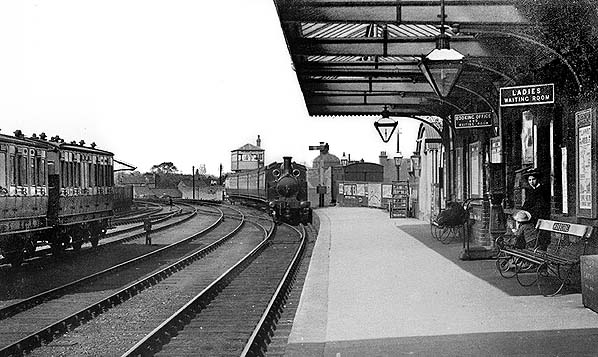
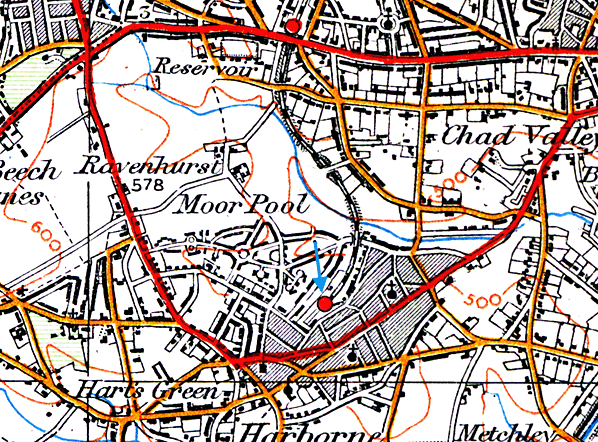
 The line opened on 10 August 1874 and it enabled Harborne to develop into a comfortable residential suburb.
The terminus station at Harborne opened on the same day as the line and was by far the grandest on the line. It consisted of a single platform with run-round loop and a 42ft turntable located at the southern end of the platform with sidings and a goods shed provided. With the building of the Chad Valley Works in 1897 goods traffic to and from Harborne increased considerably. An undistinguished single-storey brick building with a ridged roof stood on Station Road containing the booking office and waiting rooms. A glazed verandah of ridged profile extended over the platform, and a small flat awning with a serrated valance protected the station entrance.
The line opened on 10 August 1874 and it enabled Harborne to develop into a comfortable residential suburb.
The terminus station at Harborne opened on the same day as the line and was by far the grandest on the line. It consisted of a single platform with run-round loop and a 42ft turntable located at the southern end of the platform with sidings and a goods shed provided. With the building of the Chad Valley Works in 1897 goods traffic to and from Harborne increased considerably. An undistinguished single-storey brick building with a ridged roof stood on Station Road containing the booking office and waiting rooms. A glazed verandah of ridged profile extended over the platform, and a small flat awning with a serrated valance protected the station entrance.  second platform was constructed alongside the run-round loop; this was in conjunction with other improvements made along the line to provide extra capacity for the passenger service. With the building of the Harborne Estates in 1908 a lengthy footbridge was constructed which gave residents direct access to the station. The second platform was never used nor ever physically connected to the station and was removed in 1911 being replaced with additional siding space for the storage of carriages.
second platform was constructed alongside the run-round loop; this was in conjunction with other improvements made along the line to provide extra capacity for the passenger service. With the building of the Harborne Estates in 1908 a lengthy footbridge was constructed which gave residents direct access to the station. The second platform was never used nor ever physically connected to the station and was removed in 1911 being replaced with additional siding space for the storage of carriages. 
 this working, with the train being seen off from New Street by the stationmaster complete with top hat and tails. Many local residents lined the route to cheer its first passenger train for 16 years. The train was packed to capacity with enthusiasts and former regular users of the line; one such user was the guard of the final working in 1934, a Mr Perkins. Since that 1950 working the branch saw several visits from railtours with the last one coming to commemorate the final closure of the line on 3 November 1963. Hauled by LMS Ivatt 2-6-0MT No.46429 it was another SLS excursion, well loaded with enthusiasts who alighted to swarm all over the track at the terminus. The line would be lifted shortly after.
this working, with the train being seen off from New Street by the stationmaster complete with top hat and tails. Many local residents lined the route to cheer its first passenger train for 16 years. The train was packed to capacity with enthusiasts and former regular users of the line; one such user was the guard of the final working in 1934, a Mr Perkins. Since that 1950 working the branch saw several visits from railtours with the last one coming to commemorate the final closure of the line on 3 November 1963. Hauled by LMS Ivatt 2-6-0MT No.46429 it was another SLS excursion, well loaded with enthusiasts who alighted to swarm all over the track at the terminus. The line would be lifted shortly after.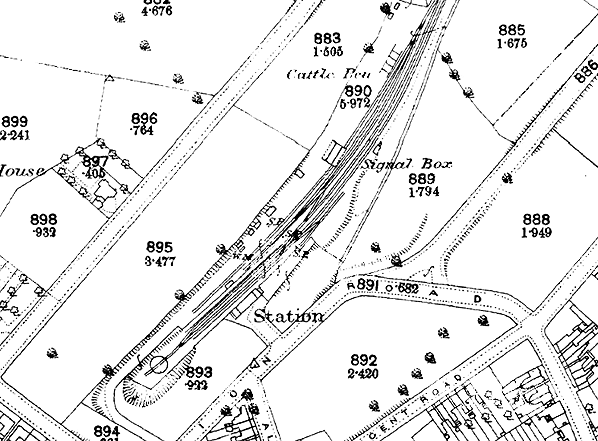 The station in its original form shown on the 1890 1:2500 OS map, during the fothcoming years the area around the station would become heavily popualted with the building of some fine Victorian houses.
The station in its original form shown on the 1890 1:2500 OS map, during the fothcoming years the area around the station would become heavily popualted with the building of some fine Victorian houses.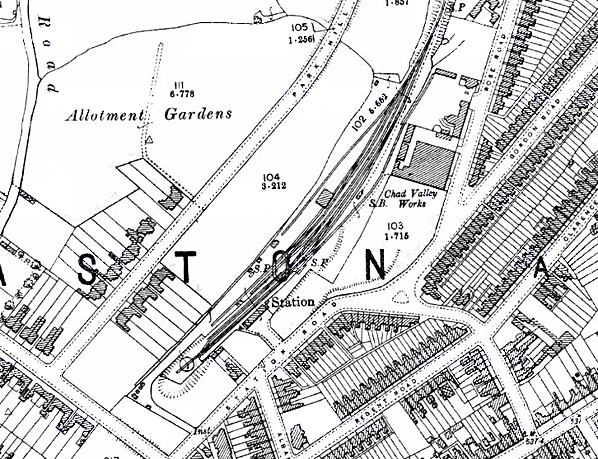
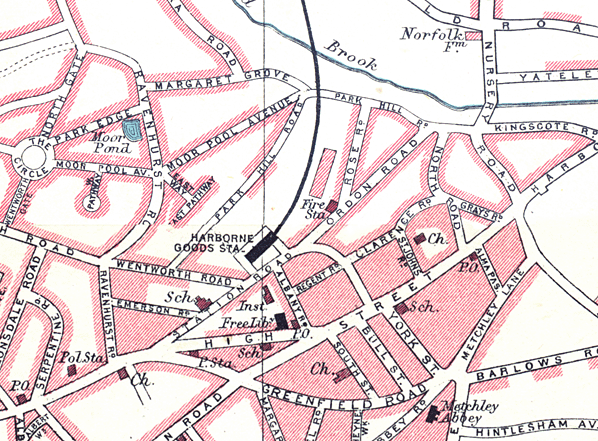
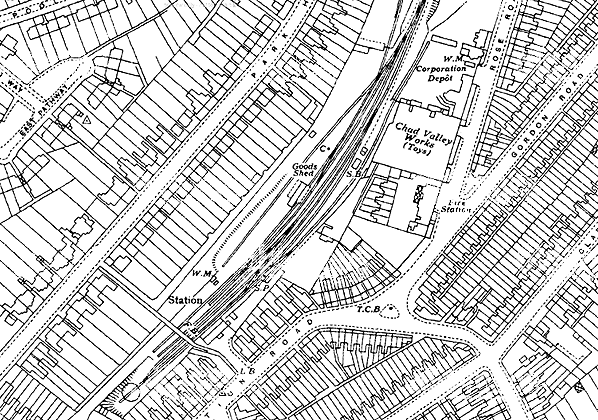
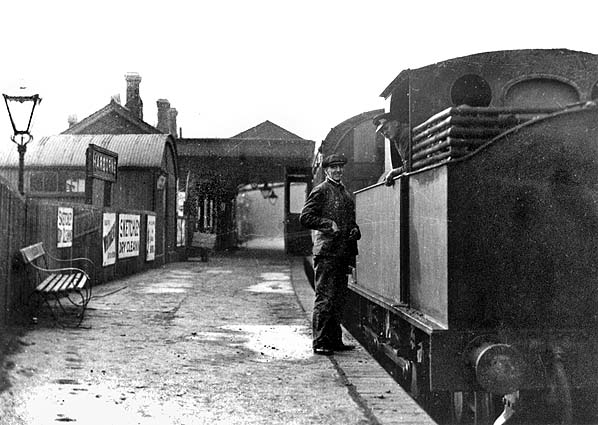
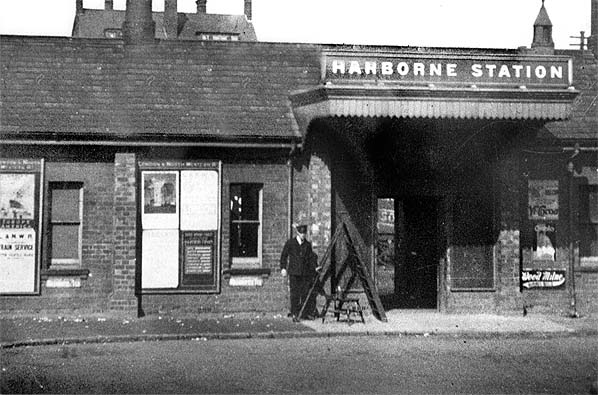
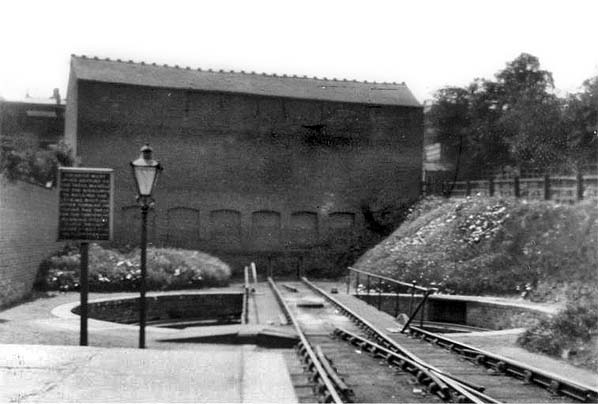
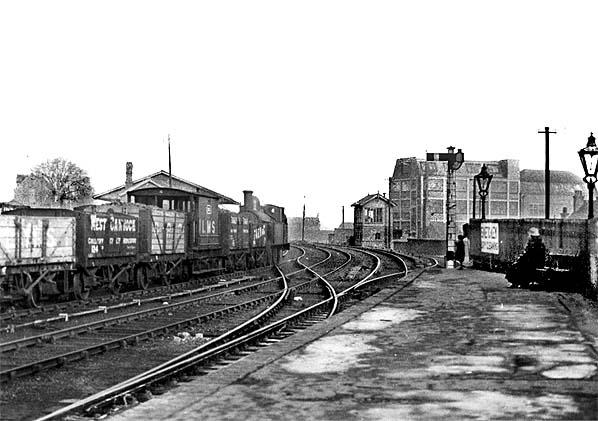
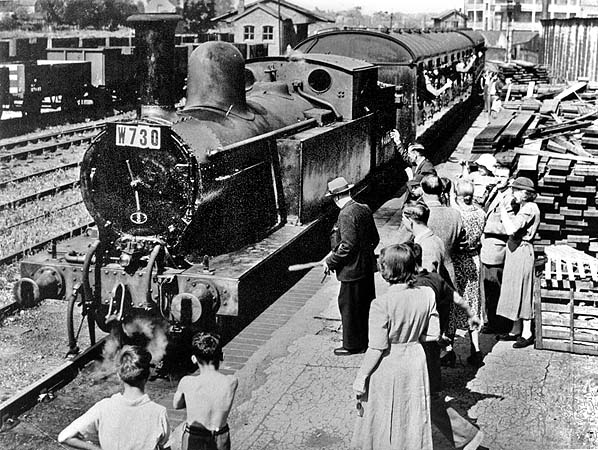
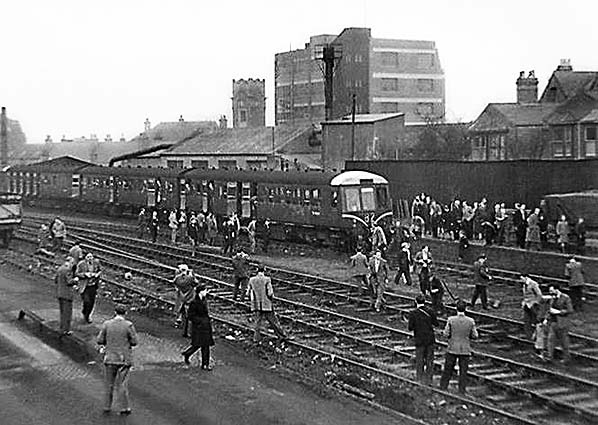
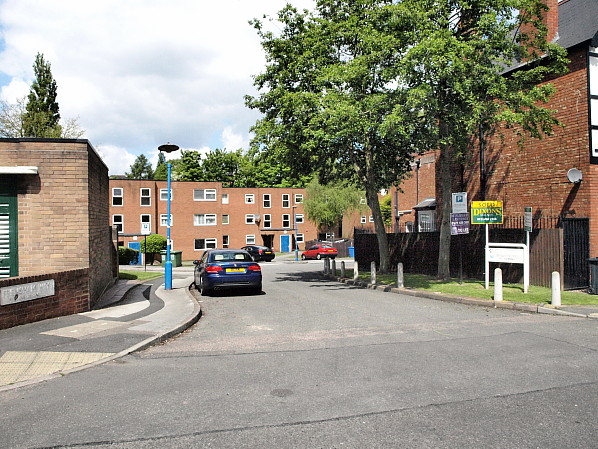

 Home Page
Home Page